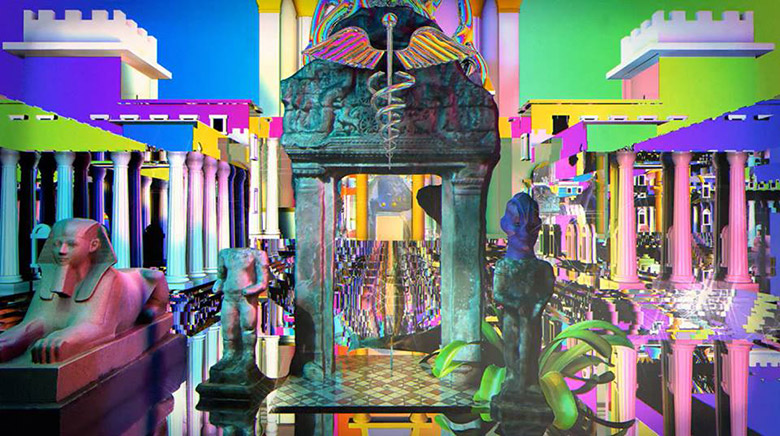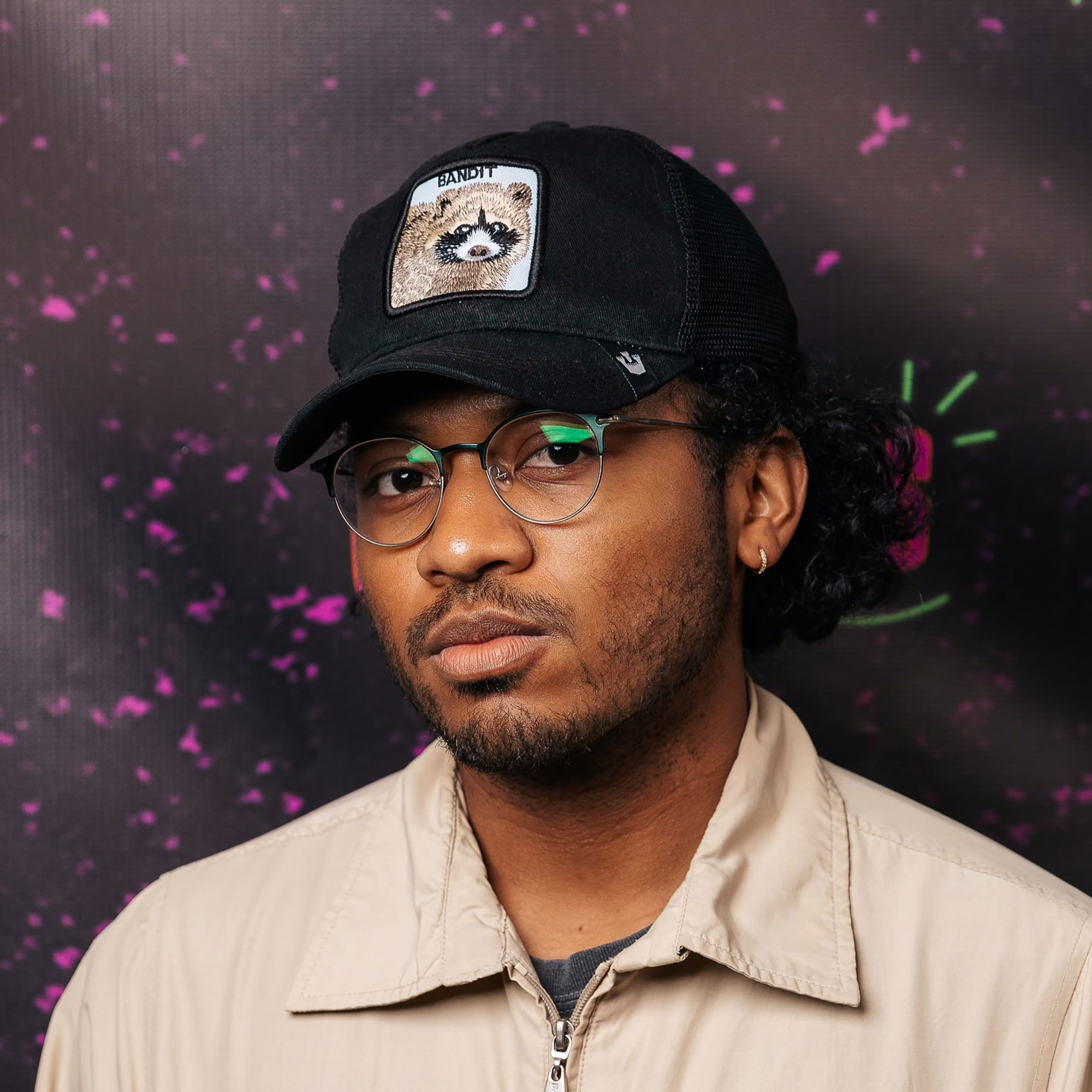
“The sun went down, and there was this white dome on the water while there was a rainbow sunset happening behind it. And the white dome must have been hundreds of feet,” recalls Williams, laughing. “It was just enormous, cause it was six miles out and it looked really big… around 1,000 feet long, and it actually went into the sunset at 1,000 miles an hour, went into the horizon around the curvature of the Earth out of our sight in like 30 seconds. So it must have gone thousands of miles an hour. That’s the most pared-down version of the story I’ve told so far.”
This was the second experience that Williams has had with UFOs, though he says it was much more intense and visually appealing than his first. “It’s just the kind of stuff that I live for, you know,” he says.
This time around was also more validating because it was a mutual experience. Not only was someone else there to observe it with him, but Williams has also since heard other accounts of people seeing white domes over the water in Malibu, including on the radio program Coast to Coast AM just a few days before this interview.
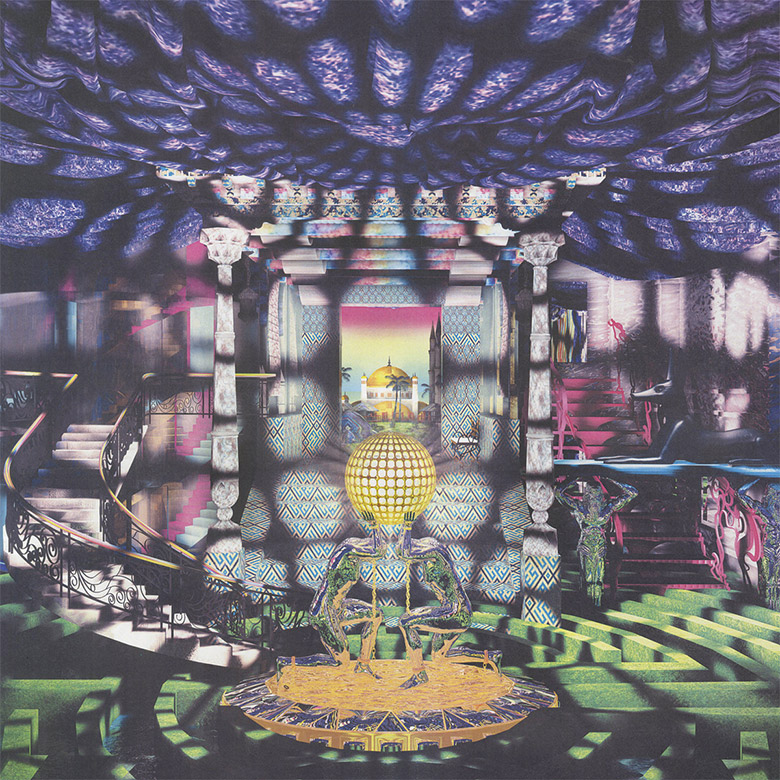
Glimpses Into A World Beyond Sense
Williams brings up this experience as an example of what he calls the “very subtle glimpses into other realms” that have informed the music videos he has made recently. In addition to creating visual counterparts to songs from his own band, Vinyl Williams, and also Trance Zen Dental Spa, his improvisational project with Chaz Bundick of Toro Y Moi and Les Sins, he has also done work for other artists, notably the video for Unknown Mortal Orchestra’s “Multi-Love”. All of Williams’ recent videos have been set in immersive, dream-like digital worlds saturated by every color of the spectrum.
“The main reason why I like to use all colors is to enter the boundary edges of our spectrum of experience [is] because this place that I’m trying to represent is another spectrum of experience that isn’t visual, necessarily,” explains Williams. “My only personal way of doing that is by maximizing from that world where we currently exist in, because it is itself a place on the edge — in terms of frequency at least — of what we can see and experience directly….”
“I’m sure there are many other ways of doing that,” he continues. “I’ve seen Japanese minimalist artists, for example, that do similar things: in-between realms and in-between entities, and objects that exist in a vacuum, or on the center of a black hole, and they can it express it really well without using any color. That’s just sort of my way of doing it.”
Williams’ vision for the digital worlds he creates doesn’t stop at the limits of his construction. As the YouTube page for “Multi-Love” explains, the video is “not only a video, but a playable interactive environment” – one where the viewer can download a few files and become a participant, exploring and manipulating the world of the video on their computer. Unknown Mortal Orchestra didn’t have any set ideas when they discussed “Multi-Love” with Williams; they simply asked for a treatment and told him to go crazy. Williams approached coming up with the treatment in the same way that he approaches the lyrics he comes up with for Vinyl Williams: automatic writing, an improvisational technique guided, in theory, by subconscious thought and energy instead of conscious intent.
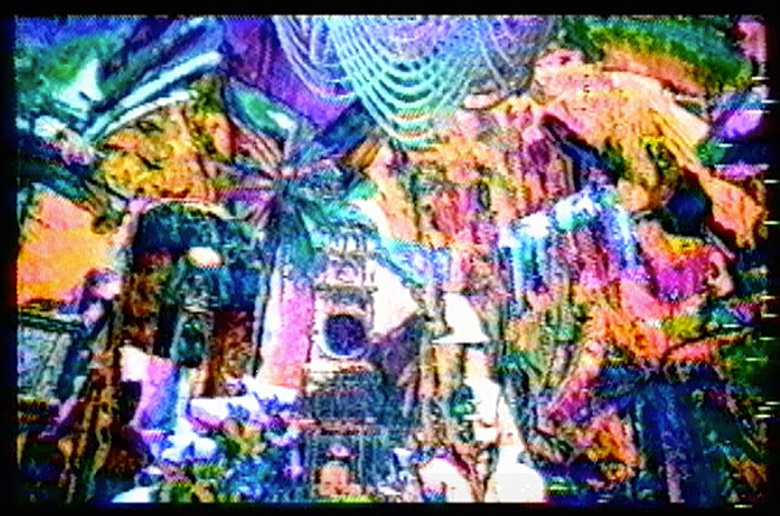
Reanimated through an analog synthesizer
Visual Digital Realms, Reanimated
It was a new experience for Williams to write a storyboard where, as he puts it, “events led to other events that are interrelated and sort of take on a life of their own that is based on the sequence of events that I preconceived, instead of it being conceived in the process of making itself.” Unknown Mortal Orchestra liked what he came up with, but Williams realized he couldn’t really do it verbatim, as he claims his animation skills with interactive worlds are limited.
“It’s very difficult for me to make really realistic settings or anything like that. So I sort of pared it down a little bit, and ended up just making as much as I could, making it as close to the idea as possible, and making it free-form enough that a player can actually go off where they’re not supposed to go and find weird areas that are glitched out. The whole thing is basically a big glitch,” he explains.
The overarching point, Williams says, was to be able to create a visual composition engine where a participant could move around, and then the feedback of objects would create new landscapes based on the contrails of their motions. The result was “supposed to be somewhat of a representation of glimpses of higher-dimensional moments, or something like that”, inspired by what Williams sees as the hermetically linked quality of the song’s lyrics. Creating a visual composition engine has always been a huge dream of Williams’ when it comes to making interactive work. He feels he has been close before, but is particularly happy with how “Multi-Love” came out.
The concept for the Trance Zen Dental Spa EP turned out a bit differently, because the visual environment is set in place and can’t be changed by the viewer.
“That whole album was an improvisation with Chaz from Toro Y Moi, and I think the music turned out really dreamy, and the interactive spa temple was pretty dreamy too, but not really that interactive,” explains Williams. “You can walk around it, but you can’t alter it in many ways. I was still more of a beginner when I made that piece, but I just wanted it to directly represent the blissful energies that happen in the music, because I feel like Chaz is a super-blissful guy to be around. It was just me, Chaz, and Ian [Gibbs], my guitarist. Ian’s also an extremely chilled out, blissful dude to be around, so that’s just sort of the music that naturally came out of being in a room together. I just sort of wanted to recreate that in a virtual space with all three of us in mind.”
“The possibilities of visual composition are pretty endless,” Williams enthuses, “and creating an infinite field is another huge goal of mine. It’s sort of every graphic designer’s dream: instead of having to meticulously create compositions, abstract compositions, figurative compositions, or both, they can just do it by moving the mouse around really fast and creating this feedback of objects that creates this completely unique abstract composition every time you move the mouse. It’s sort of, to give rise to the possibility of artists that aren’t artists to become artists, in a way.”
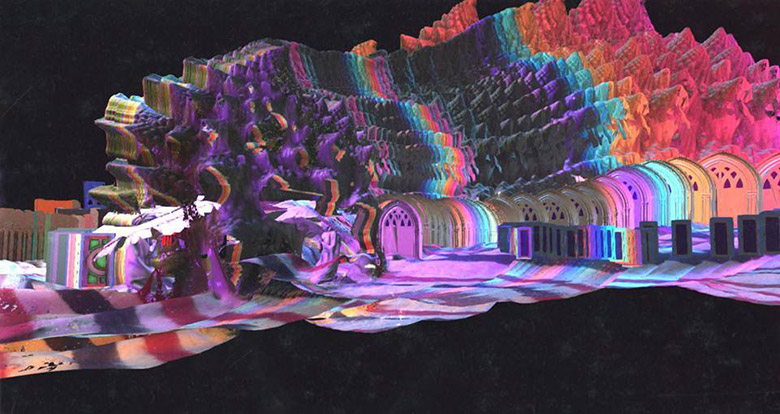
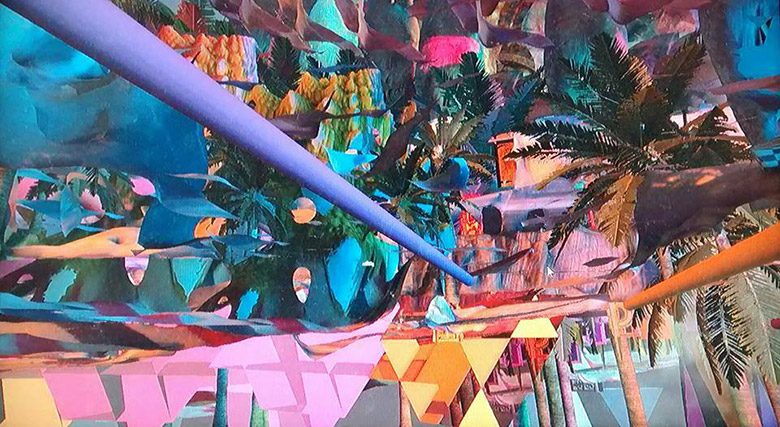
Stills from Unknown Mortal Orchestra Fans
Experiments in Artist/Audience Interaction
One of the goals of Williams’ work is to focus on the relationship between the artist and the audience. When asked what experiences first got him interested in the nature of the artist/audience relationship, he cites a Hype Williams (no relation) performance at the Echoplex in Los Angeles that happened a few years ago. Right when his set began, two female body-builders crept on stage and started flexing their enormous muscles. Williams noticed that in a dark corner of the stage there was a veiled table with what appeared to be “a female improvising with raggedy machines probably purchased from Goodwill” – then, turning next to him, he noticed that Hype Williams was suddenly in the audience, watching his own performance as a spectator. As the audience slowly started to realize what was going on, Williams began to get a sense of “a contemporary performance that can disintegrate roles of audience and performer, producer and consumer, artist and viewer, into an integrated whole.”
Williams notes the powers of harmonious music as a way the artist/audience relationship can improve, saying, “There are chords, timbres, effect combinations such as vibrato and reverb, which can simulate utopian space, and bring everybody into a physiological vacuum of beneficial waveforms. Since I don’t consider myself much as a performer, or actor, I use harmonious music to my advantage to integrate the minds of the audience with the performance itself, as well as attempt to include the opposite quality of sound with every intent.”
What he describes is something of a different approach to tearing down these boundaries than the methods employed by certain parts of early punk and post-punk movements that also spoke to breaking down performance/audience barriers. Does modern technology offer a better chance to change that relationship? Williams posits that movements such as punk might have failed in the unification of audience and performer because of a “lack of inclusion of opposites.” Music without boundaries cannot just be pretty, or harmonious, it must also be its opposite.
“Harmony juxtaposed with loudness and heaviness is a great paradox that is advantageous,” Williams says. “As many opposites as one can imagine to integrate, the closer one can get to dismantling dualities. Abrasive meditation? Extremely fast soft jams? The cliff-side of dissonance and harmony is a very thin threshold. Getting to know this tiny spectral pocket of experience can be a vital track towards unity.”
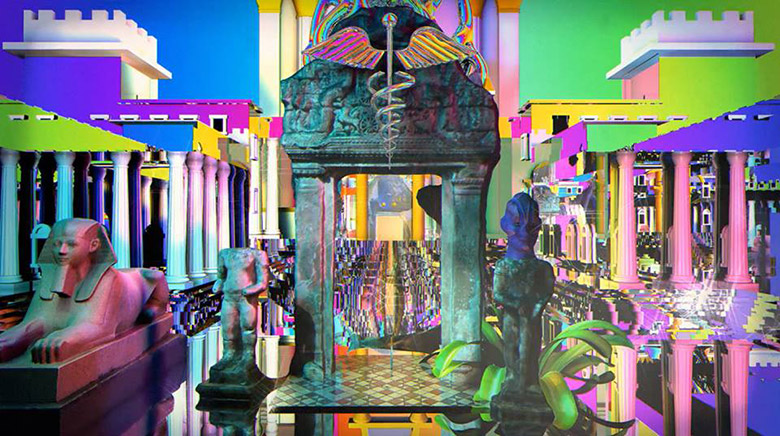
Still from Medicine – “Move Along – Down The Road” Music Video
In Pursuit of Bliss
True to Williams’ vision for artist/audience unity, Vinyl Williams’ new album, Into, swims in radiant harmonies. Though built around a fairly traditional “rock band” foundation, the album at times welcomes in a certain kind of updated New Age ambient vibe, similar to how contemporaries like Montreal’s CFCF has recently done with compelling results. Even-keeled even in its noisiest passages, like the static-y intrusions in the otherwise tranquil “Space Age Utopia”, or the ten-minute Motorik finale “Xol Rumi”, the pursuit of a blissful state is the foremost priority of Into. The album was actually finished in November 2013. There were suggestions made over the time between then and now about possible changes in regard to Into‘s hour length, but, Williams notes, “It does go through these waves and dynamics that are important to the whole album, so I just had to keep it as it is.”
Thinking of Wikipedia’s description of his band’s music as attempting to “achieve sonic matrices… to allow for an individual’s listening experience to be an aesthetic, pleasant, and contrasting sensory experience”, Williams considers how much that applies to what he wanted to achieve with Into. He sees it as stemming from his interest in Egyptian Bio-Geometry, an esoteric and somewhat elusive science. Williams describes it as a technology that siphons and seizes positive energies – one which takes the phase of detrimental wave pulses like radio waves and harmful electromagnetism from WiFi networks and flips them into having beneficial properties.
“How the waves actually look in reality isn’t just like a flat current,” he says, “but in modern science it is found that horizontal waves can have detrimental properties for biology, and vertical can have beneficial [properties].”
Egyptian Bio-Geometry can, in theory at least, turn horizontal waves into vertical ones. Such techniques could potentially affect all living organisms, but the field is still a long way away from figuring out how to do that. Williams acknowledges that in his own practices with it, he has yet to take it beyond subjectivity to a place of actually being beneficial to the listener’s health, though such a goal isn’t out of the question.
“Right now it’s still an interior process,” he admits. “I know the chords and melodies and things like that that give me that beneficial feeling. Then I sort of re-appropriate them, and reimagine how to use them in an original format. It’s not scientific by any means at this point. I had experimented with Bio-Geometry shapes. The way to measure it is a little arbitrary. You use a pendulum.”
When he was transferring Into from an initial four-track tape machine, Williams even conducted an experiment where he placed a pendulum on the tape magnet to see if he could notice a difference with the music before and after. He had hoped to see if he could actually alter the effects of the music on people when they hear it, without telling them that he had done anything to the recordings. He never discovered if it made the kind of impression that he wanted. Laughing, he admits that “it seems that it is a harmonious enough album that it might have those effects. But it’s still very subjective and I’m very okay with that… I don’t make any scientific or medical claims, obviously.”
“I was totally thinking about writing more about Bio-Geometry in the album, about how it works… but I ended up not putting anything,” he adds. “There’s almost no text, except for just the song names, the lyrics, and, you know, all the credits, which are very short actually.”
Ultimately Williams came to this decision because he wanted the listener’s experience to be more self-evident, free of the artist’s agenda – even though he acknowledges that he does have something of an agenda.
“I’m beginning to learn that, in a way, you have to destroy if you really want to create. Or, at least you have to realize the paradox with any intention that you have to get the correct effect,” Williams explains. “If you want to heal something, or you want to effect something beneficially, I feel like you have to include some kind of evil form of divinity or some kind of detriment to be able to achieve the opposite, because that’s what I feel is an essential axiom of the universe. I’m still working on it.”
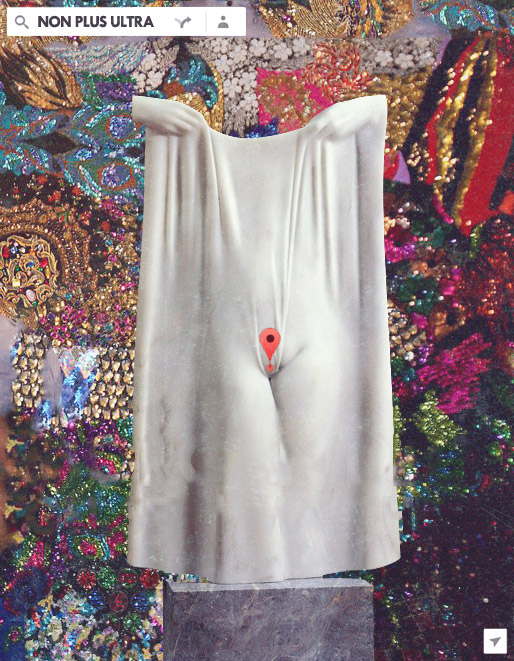
Expressing the Inexpressible
In the same way that Williams takes specific functionality into consideration when choosing chords and tones for particular songs, he also chooses and arranges his lyrics in the pursuit of those same harmonic goals. His fondness for automatic writing comes out again here; his lyrics are always re-composites or collages of bodies of poetry and other descriptive writing, often about alternate dream places and higher dimensional realms. Choosing sentences and phrases that connect to one another, he then forms melodies based on how the words sound or the feelings they describe.
“I will definitely replace a good melody with good descriptive lyrics,” he says, while countering that it’s also a different experience with every song. “I just sort of improvise… and then layer and layer until it starts to sound like something beyond myself.”
His automatic writing isn’t limited to his words, but extends to how he arranges and records the music as well.
“With the songwriting, I let the guitars sort of resonate themselves with a lot of compression, delay and reverb, so that the guitars are sort of composing themselves. And the drums are very repetitive. I’ll record a beat for ten minutes, and then I’ll pick the best three or four minutes… an entire song can be written around that,” h says. “The intention is, I guess, my own expression of the inexpressible.”
Williams was right to stand by Into‘s sequence and running time: its fourteen songs feel naturally connected. He says there definitely is a narrative to the album, but it’s one that he’s only just starting to uncover himself, because it wasn’t intentional.
“Through the videos I make for each song, these interactive pieces I’m making for it – it’s sort of adding on to the narrative, even though it’s not like a normal story with characters at all,” Williams says. “It’s more of an intangible journey that one can have. And it’s totally open to the individual; it’s definitely not something that is specific enough to create a screenplay or film. It could be heavily, heavily interpreted.”
Individual interpretation aside, Williams notes that within the album’s themes there is definitely a journey based on ancient traditional texts, and also the Corpus Hermeticum, a sizeable volume that combines different mystical traditions like the Tibetan Book of the Dead, the Egyptian Book of the Dead, Gnostic and ancient Christian beliefs from 200-300 AD, and puts them all together into a “multi-faceted dream journey of a description of the afterlife.” As influenced as he is by such writings, he claims he doesn’t try to represent them directly, but to create his own, in a way.
It has become more and more common for artists to work across different mediums, but Williams’ vision, which is uniquely open-ended yet consistent, pulls written, audio, and visual mediums into one embrace. For him, they are all linked, and if one has taken precedent over another up to this point, he’s actively looking to correct that.
“Language is the quintessential blueprint that can bridge between the senses. The more I attempt to describe music in visual terms, and the visual in musical terms, the more I’m training toward synesthesia,” Williams describes. “It’s not an ability that I naturally have, but I’ve developed it through language. It constantly informs the relationships between the senses, slowly unveiling the world of noumena; things outside of the cognitive mechanism. Lately, I spend more time working visually. I’ve been a musician for a lot longer than I’ve been a visual artist. I’m balancing my abilities at the moment, trying to equalize them.”
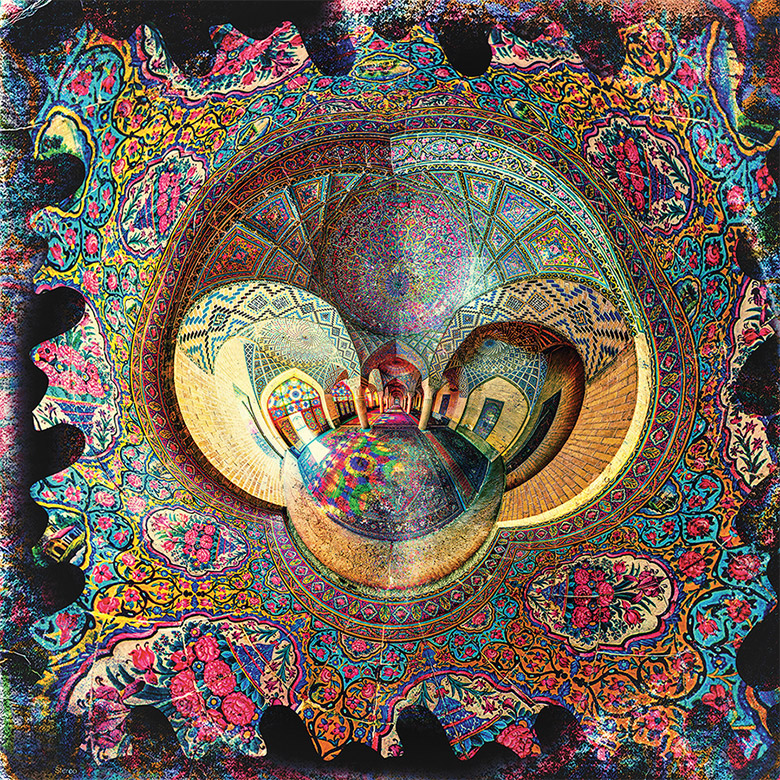 Vinyl Williams – Into Album Artwork
Vinyl Williams – Into Album Artwork
Vinyl Williams Music Video Gallery
Unknown Mortal Orchestra – “Multi-Love”
Vinyl Williams – “World Soul” Music Video
Trance Zen Dental Spa
Ω

